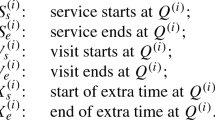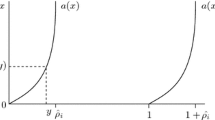Abstract
Polling system models are extensively used to model a large variety of computer and communication networks as well as production and service systems in which multiple customer classes or a number of distinct items compete for the capacity of a common server or production facility. In this paper we describe an efficient approximation method for the steady state distributions of the queue sizes and waiting times. This method is highly accurate as demonstrated by an extensive numerical study. In addition, it is highly adaptable to a variety of arrival patterns and switching protocols, including exhaustive and gated regimes, simple cyclical systems as well as general polling tables. For a system withN stations, one finds the firstK probability density function values of the steady state queue size in any given station inO(max(N, K 2) time only. When executed on an IBM system RS/6000, we have observed an average CPU time of less than 1 second for systems with as many as 50 stations over a large variety of parameter settings.
Similar content being viewed by others
References
R.M. Adelson, Compound Poisson processes, Oper. Res. Quarterly 17 (1966) 73–75.
Y.J. Aminetzah, An Exact approach to the polling system, Ph.D. Dissertation, McGill University, Montreal, P.O., Canada (1975).
J.E. Baker and I. Rubin, Polling with a general-service order table, IEEE Trans. Commun. COM-35 (1987) 283–288.
J.P.C. Blanc, A numerical approach to cyclic-service queueing models, Queueing Syst. 6 (1990) 173–188.
O.J. Boxma, Workloads and waiting times in a single-server systems with multiple customers classes, Queueing Syst. 5 (1989) 185–214.
O.J. Boxma, H. Levy and J.A. Weststrate, Optimization of polling systems, in:Performance '90, eds. P.J.B. King, I. Mitrani and R.J. Pooley (North-Holland, Amsterdam, 1990) pp. 349–361.
O.J. Boxma, H. Levy and J.A. Weststrate, Efficient visit frequencies for polling tables: minimization of waiting cost, Queueing Syst. 9 (1991) 133–162.
S. Browne and U. Yechiali, Dynamic routing in polling systems, in:Teletraffic Science for New Cost-Effective Systems, Networks and Services, ITC-12, ed. M. Bonatti (Elsevier Science/North-Holland, Amsterdam, 1989) pp. 1455–1466.
S. Browne and U. Yechiali, Dynamic priority rules for cyclic-type queues, Adv. Appl. Prob. 21 (1989) 432–450.
G.L. Choudhury, Poling with a general service order table: Gated service,Proc. IEEE INFOCOM '90, San Francisco, CA, USA (1990) pp. 268–276.
B.T. Doshi, Single server queues with vacations, in:Stochastic Analysis of Computer and Communication Systems, ed. H. Takagi (North-Holland, Amsterdam, 1990) pp. 217–265.
M. Eisenberg, Queues with periodic service and changeover times, Oper. Res. 20 (1972) 440–451.
M.J. Ferguson and Y.J. Aminetzah, Exact results for nonsymmetric token ring systems, IEEE Trans. Commun. COM-33 (1985) 223–231.
S.W. Fuhrmann and R.B. Cooper, Stochastic decompositions in theM/G/l queue with generalized vacations, Oper. Res. 33 (1985) 1117–1129.
O. Hashida, Analysis of multiqueue, Rev. Elec. Commun. Labs. 20 (1972) 189–199.
V.V. Kalashnikov and S.T. Rachev,Mathematical Methods for Construction of Queueing Models (The Wadsworth & Brooks/Cole Operations Research Series, California, 1990).
A.G. Konheim, H. Levy and M.M. Srinivasan, Descendant set: An efficient approach for the analysis of polling systems, IEEE Trans. Commun. COM-42 (1994) 1245–1253.
H. Levy, Delay computation and dynamic behavior of nonsymmetric polling systems, Perf. Eval. 10(1989) 35–51.
K.K. Leung, Cyclic-service systems with probabilistically-limited service, IEEE J. Sel. Areas Commun. 9 (1991) 185–193.
D. Sarkar and W. Zangwill, Expected waiting time for nonsymmetric cyclic queueing systems — Exact results and applications, Manag. Sci. 35 (1989) 1463–1474.
M.M. Srinivasan, H. Levy and A.G. Konheim, The individual station technique for the analysis of polling systems, Technical report, The University of Michigan, Ann Arbor, MI (1992).
H. Takagi,Analysis of Polling Systems (MIT Press, Cambridge, MA, 1986).
H. Takagi, Queueing analysis of polling models: An update, in:Stochastic Analysis of Computer and Communication Systems, ed. H. Takagi (North-Holland, Amsterdam, 1990) pp. 267–318.
H.C. Tijms,Stochastic Modeling and Analysis: A Computational Approach (Wiley, Great Britain, 1986).
R.W. Wolff, Sample-path derivations of the excess, age, and spread distributions, J. Appl. Prob. 25 (1988) 432–436.
Author information
Authors and Affiliations
Rights and permissions
About this article
Cite this article
Federgruen, A., Katalan, Z. Approximating queue size and waiting time distributions in general polling systems. Queueing Syst 18, 353–386 (1994). https://doi.org/10.1007/BF01158768
Received:
Revised:
Issue Date:
DOI: https://doi.org/10.1007/BF01158768




